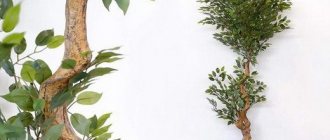How to pinch a ficus to bush - step by step
If you pinch the ficus correctly so that it bushes, a very beautiful decorative flower will grow. With timely correction, it will not grow upward, but will produce lateral shoots and splendor. How to pinch a ficus and at what time it is painless to carry out this procedure, we will consider in this article.
- Step-by-step pinching process
- How to pinch if it reaches up
- How to make it branch
- How to make side shoots sprout
- Questions and answers
- When is the best time to carry out the pinching process?
- Why do you need to pinch ficus?
- Which ficus trees do not need pinching?
- Features of pinching different types of ficus
- Ficus benjamina
- Ficus rubbery
- Further care for ficus
Required tools and materials:
- Container with water.
- Disinfection solution.
- Knife, pruning shears with sharp blades.
- A rough piece of material for wiping.
Procedure and important points on how to pinch:
- Make sure the plant has reached an acceptable height. Wipe the instrument with disinfectant liquid. This could be a solution of chlorhexidine, vodka, alcohol or another substance with the desired effect. Check the sharpness of the blade. The first pinching option is suitable if the ficus has not outgrown and its height is optimal. Trim the top, thin shoot slightly below the growth line with a straight cut.
Avoid contact with mucous membranes. If this happens, rinse quickly with plenty of running water.
- We trim the overgrown plant differently. At an acceptable height (a place above which further growth is undesirable), you will find a twig or leaf that grows below this point. Cut 6 - 8 centimeters above the leaf or branch (use an oblique cut). Also focus on the bud on the other side of the trunk - the lower edge of the cut should be in line with the bud, and the upper edge above it.
- Dampen a piece of cloth with water. Use it to remove the released juice from the trunk. At this point, the treatment is completed and the flower will cope with wound healing on its own. Do not reuse the cloth used to remove the juice, but throw it away.
- To help your ficus grow more actively, be sure to use fertilizer within a month after pinching. Replace part of the soil in which it grows. Can be transplanted into a larger container. A year later, in the spring, perform a similar operation with side shoots. The result will delight you with splendor and beauty.
Do all plants need pinching?
Pinching is possible.
The procedure is required if necessary to stop excessive upward growth and increase the number of side branches for splendor. That is, to create the desired appearance (volume and height). Not every ficus responds well to such actions to improve it. Some of them do not want to bush to the side. Watch the green pet. If you don't see the desired result, go another way. Plant 3-4 cuttings in one container and after a while you will see a lush bush.
Replanting after purchase
Ficus Lyrata should be quarantined away from other plants as soon as it is brought into the house. It should last for at least 2 weeks, during which owners should regularly check the leaves, trunk, and petioles for signs of disease or pest infestation.
Only after this should you consider whether it is worth replanting the plant in another pot. Ficus Lyraea is not transplanted:
- purchased at the end of summer, autumn or winter, and although the plant is cramped in an old pot, it does not experience much discomfort.
- if it is a seedling purchased from amateurs or at an exhibition, growing in mixed soil and not having time to fully form clumps;
- the ficus was recently transplanted;
If the ficus arrives in a shipping container from Holland, Poland or other countries, it usually “sits” in clean peat. This allows the plant to cross the border without additional costs and time for analyzing the substrate. The plant feels uncomfortable there, but it is much worse to disturb the roots during the dormant period.
To determine if your lyrata plant is in immediate need of repotting from its shipping container, remove the root ball and inspect it carefully. The signal to urgently replace the ficus pot is:
- Most of the shoots of Ficus Lyraea have rotted or dried out;
- The peat is not visible through the tangled roots;
- the substrate has an unpleasant odor;
- It dried out so much that it turned to stone;
- the owners are beginners or not very careful gardeners and are not sure that they will be able to keep the substrate perfectly dry without under-drying or over-drying until at least mid-February.
Pure peat in a dry state does not absorb moisture well and remains wet for a long time if it is over-watered. It is better to take a chance and replant the ficus than to subject it to stress again and again due to improper handling, especially during the dormant period.
The lyrata is transplanted into a new pot, having first checked and cleaned the roots, if necessary. Remove some of the peat with a stick and sprout the lower side shoots. The container must have holes for draining water, and drainage should occupy 1/5 of the volume.
For ficus and palm trees, it is recommended to use ready-made soil. It is specially designed for these crops, light, permeable and filled with balanced fertilizer, which allows you to do without fertilizing for the first 1-2 months.
After transplanting, Lyrata should be watered abundantly. Place it in the shade and mist it frequently. As soon as the ovaries of a new leaf appear, it is moved to a permanent place.
Formation of the rubber ficus crown
To perform the procedure, you need to prepare: a knife or pruning shears, a solution for disinfecting instruments (alcohol or hydrogen peroxide), a soft cloth, a container of water. How to pinch rubber ficus? To do this, follow the instructions below:
Ficus juice is poisonous, so all manipulations are carried out with gloves.
Reproduction methods
Ficus Lyras produces roots when propagated by leaves, but that's where it ends. It will sit in the ground until the slab gets too old and will die naturally if it has not previously suffered from overwatering or over-drying.
There is not enough genetic material in fig leaves to grow into a new plant. Lyrata is easily propagated by cuttings or grafting.
Cuttings
Root cuttings taken in spring can be rooted using
- peat-sand mixture;
- water;
- perlite;
- light backing.
The advantage of a liquid substrate is that the seedlings are clearly visible in it, and Ficus liriformis reproduces best when it reaches 2-7 cm. In the substrate, the risk of rotting is less, but the rooting process is not visible. This usually takes 3-4 weeks.
The lyre-shaped leaves are very large, and the evaporation area is large. After cutting the cuttings, remove those that will be in water or substrate, roll the remaining blades into a tube and secure with an elastic band or piece of fabric. If rooting is done in a mini-greenhouse, this is not necessary.
Air layering
To properly propagate ficus Liriform by grafting, it is recommended to follow the step-by-step instructions:
- Select a shoot at least 20-25 cm long, the lower 10 cm of which are semi-lignified and have a diameter of 0.4-1.5 cm.
- Remove all leaves on the crown except 2-3. It is better not to leave a single leaf, as it may die, which will interfere with rooting, and it is unknown how the growth buds will behave.
- Select a node in the center of a semi-threat zone. Make 2-4 cuts, cutting through the bark but not touching the wood.
- Remove milky juice.
- Treat wound surfaces with Lirata root stimulator.
- Wrap the wounded area on the trunk with sphagnum moss or coconut fiber soaked in warm water.
- Wrap in film.
- Tape the ends.
- Keep peat moss or fiber moist.
- When the roots fill the interior space limited by the foil, trim the cuttings and plant them in a light medium.
FORMATION OF A TIERED STAMP OF A HOME FICUS
The process can then be represented in the following steps:
- As soon as the ficus reaches the desired height, it needs to be cut off at the top.
- If it is planned to form a two-level trunk, then the ficus crown must be divided into three parts: the 1st and 3rd are located on top, these are the levels that will be spherical, and the 2nd part is between the levels, it is freed from all shoots.
- If it is intended to form 3 levels, then the crown must be divided into five parts. 1,3 and 5 are the upper future levels, which are given the shape of a ball, and 2 and 4 are the distance between them, freed from all shoots.
- You can form the levels from top to bottom, but then the top of the stem cannot be removed until the ficus grows to the desired height.
All care for such a multi-tiered ficus will boil down to cutting off all the overgrown shoots on the bare part of the trunk and removing some young shoots that grow inside the crown and thicken it.
From some ficus trees that have small leaves, for example, Ficus benjamina, you can, if desired, form real green figures in the form of a ball, pyramids, cubes, in the shape of animals and birds.
general description
"Lirata" comes from the tropical forests of Africa. In nature, it reaches a height of 13 m. At home, by trimming the crown, a compact tree shape is achieved. You can also reduce growth by placing the ficus in a small pot. On average it grows to a height of 2.5-3 m.
The ficus "Lirata" received its name due to the similarity of the leaf with the silhouette of a lyre. It has wide leaves with distinct veins and wavy edges. Light green veins stand out against the dark background of the leaf.
The base of the leaf is narrower, the apex is rounded. The leaf grows 35-50 cm in length and 22-25 cm in width. The surface of the sheet is glossy, requiring constant care.
The foliage must be sprayed or wiped with a damp cloth every 2-3 days . The trunk of the ficus "Lirata" is straight, rough, brown with a gray tint. Rare aerial roots extend from the trunk, eventually growing into the ground.
In addition to Lirata, there are also a huge number of types of ficus, including Triangular, Dwarf, Blunt, Moklame, Ali, Small-leaved, Microcarpa, Pumila White Sunny, Creeping and Ampelous. All of them are very popular among gardeners.
Crown formation without pruning
Before pruning the rubber ficus, think about whether it is necessary to do so. The crown can be formed solely by directing and fixing certain shoots. Using this method minimizes injury to the plant. After a certain time, these fixing devices can be safely removed.
It is also worth considering the age of the ficus. A younger plant tolerates this procedure more easily. But adult plants no longer have sufficient shoot flexibility, and they are very easily injured.
Prevention and treatment of diseases and pests
The best way to prevent ficus diseases is proper care. Most often, lyrata is affected by various types of rotting due to overfilling. They are especially dangerous in combination with poor lighting and low temperatures. Moisture can even cause mold to appear on the leaves and trunk.
The most dangerous pests include:
- Scabies mites;
- Spiders;
- powdery mildew;
- Spider mite; powdery mildew; powdery mildew; false mole.
Aphids and whiteflies rarely attack Ficus liriformis, even if infected plants are nearby - they are difficult prey for most insects. Diseases are controlled using fungicides. Pests are destroyed using insecticides; Aktelik is traditionally used for indoor plants.
Rules for pruning that is safe for the plant
First of all, in order for pruning to bring maximum benefit and not harm the flower, you must use a sharp, disinfected knife or pruning shears; scissors are suitable for thin branches. To peel off, you need to retreat 10-15 cm from the top, that is, approximately 3-4 leaves.
In addition, experts recommend using gloves and glasses when pruning ficus, since the milky sap contains toxins that can trigger the development of an allergic reaction. Pruning is best done in the spring, when the plant begins its active growth phase. It is during this period that you can get the maximum result.
Experienced gardeners recommend carrying out manipulations when the height of the flower reaches 70 cm. It must be remembered that removing most of the stem can lead to the plant stopping growing and remaining the same size.
How to choose the time for pinching
Like pruning any plant, pinching is best done every spring at the same time. To be more precise, at the end of February - beginning of March.
Why early spring? Because the end of spring is the period when sap flow begins, and our pinching will awaken the flower to rapid growth. But the side shoots will be thin and weak.
Let's list the benefits of spring pinching:
- life processes are activated;
- rapid healing of open wounds;
- Only in spring do young shoots begin to grow.
To trim the top, take any convenient tool: knife, blade, scissors. The main thing is that it is very sharp and disinfected. We will not provoke the appearance of fungus or infection.
By the way, we also have an article about ficus pruning in general.
Types of ficus pruning
There are two main types. They are used depending on the goal being pursued.
Sanitary
To ensure proper care of the flower, you should inspect it from time to time. This will help to promptly identify branches that are damaged or have begun to dry out. But some types of deciduous ficus expose their crown only with the onset of autumn. You can notice diseased shoots only at this time. They must be removed immediately to prevent the disease from spreading to the entire plant.
At the same time, remove weakened and old branches, because they are easy prey for infections and pests. Shorten it completely, along with the damaged area. When a diseased shoot grows from the ground, it should be cut down to the ground.
Rejuvenating
This method is used when the flower has suffered from the cold or has begun to dry out. You can ensure that it produces a lot of young shoots again by cutting off the branches so that only one stump remains. Such actions stimulate the development of new root shoots. Indoor varieties of dwarf ficus respond well to this. A plant with long branches and drying leaves due to excessive low growth has only 2 buds. This stimulates the appearance of many cuttings. From them you can grow new plants or form a beautiful crown on an old trunk.
Watch this video on YouTube
Be careful!
The milky sap of ficus is poisonous to humans. Perform pruning when there are no children or pets at home. To protect yourself, wear rubber gloves. Collect all cut parts in a bag and throw them into the garbage disposal.
When you take a flower into the shower, you may accidentally break off a leaf or shoot. Make sure that the fragments do not lie on the floor where kids can find them and try to chew them. Of course, one bite will not poison a child to death, but a burn to the mouth and a long roar will also not bring joy to the mother.
You can explain to older children that the plant is dangerous, so you should not pick off its leaves. If there are babies living in the apartment, it is better not to place the tub on the floor, but to raise it on some kind of stand. Please note that the plant is heavy. The support must be reliable so that the bush does not tip over on people.
Bright flowers do not bloom on ficuses, but the green plant itself serves as a good interior decoration and a natural air filter. If you prune it correctly, a compact tree will appear in your house. With good imagination, the bush can be given such a bizarre shape that it can compete with Japanese bonsai in terms of decorativeness. Create original compositions that will fit into any interior in style.
goodgrunt.ru
Galina Khachko 06/04/2014 | 19403
Many gardeners cut and pinch the top of the ficus to prevent the flower from growing into one trunk. However, this does not always lead to success. In this case, the Japanese pruning method can help.
When forming the crown of trees, Japanese gardeners use the “gentle pruning” method - the branches are twisted into a ring until they reach a bud, from which a replacement branch will then develop. This is the method I remembered when my ficus trees reacted to a change in location with a sharp fall of leaves.
In early spring, having begun renovations in the southern rooms, we moved our pets to monsteras and other aroids, which grow in our rooms facing north. Additional lighting has been installed there. There were a lot of plants and they had to be literally piled up. There was clearly not enough lighting for everyone, so they soon installed additional lighting. But if the ficus Benjamin’s thick “hair” only thinned out slightly, then the rubber-bearing ficus Tricolor had everything much worse. Even though she had piled him right up to the ceiling next to the lamp, he dropped sheet after sheet.
Of course, it could be cut off and the top rooted, but then one would have to wait three years until the plant acquired its former size and former beauty. And then I remembered the Japanese method and made up my mind - I very carefully bent the top of the ficus with a loop (by that time there were three leaves left on the plant) and not very tightly bandaged it to the stem between the buds.
The bark at the bend only slightly burst, milky juice came out, but no deep cracks formed. Now that the ficus has shrunk in size, it fits perfectly on a sunny windowsill. And when summer came, it “moved” to the garden, where we placed it in the rose garden along with other indoor plants. By that time, buds had awakened on the entire stem of the ficus up to the “loop” and leaves were peeking out from them in the cone phase. The ficus looked like a “thorny” rose.
In the fall, the plant was returned to the windowsill of a sunny window, but with a mass of side shoots, they were even on a loop at the bend (photo 1) .
To keep the crown symmetrical, it was periodically turned all winter, and by spring it turned into a lush bush. The ficus has a leader shoot, which I plan to shorten soon (photo 2) , remove the loop, and thereby obtain material for cuttings.
I note that I did not replant the ficus, did not change the soil or feed the plant. Only it got a little extra when I foliarly fertilized the roses with Baikal EM-1 solution.
Inspired by a successful experiment, I applied it on a large ficus bush of the Black Prince variety to reduce the height of the crown, since the plant had already reached the ceiling (photo 3) .
I also used this experience when growing ficus benjamina and hibiscus in bonsai form to make the shoots “weeping.” Only I bandaged the branches not to the stem, but to pegs stuck into the soil around the perimeter of the pot.
indoor.usadbaonline.ru
Home care
A tropical plant requires the following rules of care at home:
- compliance with the watering regime;
- timely feeding;
- transfer.
Watering
In summer, this type of ficus requires abundant watering. Watering is carried out when the ball of soil has dried by 2 cm, but if the substrate is wet, watering is not recommended. Despite the fact that ficus needs moist air, an excess of water in the soil will have a bad effect on the plant.
In order for the soil to absorb water faster, it must be loosened. Water for irrigation should be settled and at room temperature. You need to let the water sit for a week; after watering, you should drain the water from the saucer, since bacteria can grow in it.
Ficus lyre or violin (Ficus lyrata). Care, reproduction, formation.
Ficus lyrata (Ficus lyrata) is an evergreen tree from the Mulberry family (Moraceae) that differs from other ficus trees in having larger leaves.
The homeland of this plant is tropical Africa, where it easily reaches 12 meters in height; at home its size is somewhat more modest, about 3 meters. The name ficus comes from the Latin word "lyratus", which translates as "lyre-shaped". This name was given for a reason, but for the similarity of the outline of the leaves with the silhouette of a violin or lyre.
The lyre-shaped ficus is one of the most demanding representatives of the ficus family, but it compensates for this with its original appearance, which will decorate any room. Other types of ficus can be found in a separate publication Types of ficus grown at home.
Ficus lyre-shaped: propagation and care at home
Typically, green spaces of this genus are rubber-bearing plant species, but this does not apply to the lyre-shaped ficus.
In modern apartments this species can easily reach a height of two and a half meters. Lyre-shaped ficus is usually larger than its counterparts. It blooms extremely rarely at home, and its flowers are not particularly beautiful. The fruits that result from flowering are inedible , which distinguishes them from the fruits of other ficus species.
Trimming different shapes
- Bush shape. To create this shape, you need to pinch the main shoot at a distance of 9–14 cm; subsequently, shoots will begin to form only on the sides. At a height of approximately 9 cm, they also need to be pinched. If the crown of the ficus is too voluminous, then some of the shoots can also be cut off from the inside.
- Standard tree shape. To create this form, a ficus with a straight trunk is suitable, leave only 5 upper shoots, the rest located on the sides must be removed. When the ficus reaches the height you need, you need to pinch the top bud, this is necessary so that the shoots on the side begin to grow. Once this happens, the plant can be given a rounded shape. If the ficus trunk is not yet strong, then for its stability you can tie it to a peg, which is then removed.
- Arc shape. This form is best taken by liana-shaped varieties of ficus. This flower is considered a shrub plant, so its trunk is not very flexible. But, if you place an arc-shaped wire frame near the cutting, then everything will work out. In order for an elastic shoot to emerge from the upper bud (which can be passed along the frame), a pinch should be made every few leaves.











